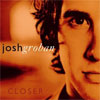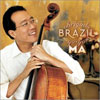 Crossover artists play to a
harmonic confusion
Crossover artists play to a
harmonic confusion
August
6, 2004
By
OLIN CHISM / The Dallas Morning
Newsc
The
Three Bs used to symbolize classical music. But Bach,
Beethoven and Brahms are being muscled out by names
many concertgoers wouldn't even recognize. Take Billboard
magazine's list of "top classical albums." Nos. 10,
11 and 15 are by the Klazz Brothers, André Rieu and
Tim Janis. Yes, that's the classical list.
| |
Josh Groban |
 Closer Closer
European
flaovored romantic ballads in three languages
-- Italian, English and
French
-- with lush orchestrations and subtle sound
effects. Violinist Joshua Bell contributes
to one track
Olin Chism
|
If
you move to the "classical crossover" chart, you
find Josh Groban and Hayley Westenra at the top
and, further down, Bond, an all-female "string quartet"
that would put the audience in shock if the a metro
symphony orchestra dared book them for a subscription
concert.
Traditional
classical still hangs in there, with cellist Yo-Yo
Ma and violinist Joshua Bell leading the way. In fact,
Mr. Ma has three entries in the two charts. He heads
the classical list (he's been there for weeks) and
he has two albums on the crossover chart.
It's
easy to see all this as merely a matter of marketing
or cynical exploitation. But there seems to be something
deeper involved, a breaking down of barriers that
has classical musicians moving into what used to be
pop territory and pop musicians nibbling around the
edges of the classical pie. The world of music is
changing, and the result may be something the Three
Bs would hardly recognize.
"Crossover"
is one label applied to this change. In some circles,
it's a cuss word, but the idea has its defenders even
among classical musicians. One thing for sure: It
has an audience, which is quite distinct from and
generally younger than traditional classical audiences.
Crossover
is an amorphous term covering several styles of music.
Its most popular practitioners, such as Mr. Groban
and Ms. Westenra, as well as longtime favorites such
as Andrea Bocelli and Charlotte Church, perform music
that's more easily defined by what it's not: not rock,
rap, soul, not quite opera or art song, either.
They
have pleasant voices and sing pretty melodies backed
by lush orchestrations heavy on strings or electronically
generated simulations of strings.
| |
Yo-Yo Ma |
 Obrigado
Brazil Obrigado
Brazil
The world's most famous cellist joins a small
group of friends for an hour and 12 minutes
of atmospheric Brazilian music, often highly
rhythmic but sometimes pensive as well.
|
Aside
from Mr. Bocelli, who relies heavily on opera for
his material, connections to classical music are often
hard to find. Those who approach the genre from the
classical side, such as Mr. Ma and Mr. Bell, often
perform folk-flavored or world music or music coming
out of films.
However
they're tagged, classical and crossover represent
only a small portion of the total recordings sold.
Geoff Mayfield, director of charts for Billboard,
says that a classical album needs to sell 3,000 to
7,000 copies a week to make No. 1 on the classical
chart, with 4,000 being the average. For crossover,
it's 3,500 to 7,000 a week, with 4,500 being the average.
Yet
6,000 copies a week will barely land you on Billboard's
Top 200 list of all recordings released, which is
probably the magazine's most-quoted chart.
But
Mr. Mayfield says that these figures don't tell the
complete story. A new recording by Mr. Bocelli or
Mr. Ma can easily move out of the range. Mr. Ma has
been well into the Top 200 several times.
The
driving forces behind crossover are both artistic
and economic, according to Peter Gelb, president of
Sony Classical, a major force in the movement.
"It
was born out of necessity," he says of his company's
shift in recording philosophy. "Because the classical
music repertory had been recorded over and over and
over again, it was not surprising that the audience
would diminish. Eventually, it reached the point where
the pure economics of recording, say, a Beethoven
symphony yet again for the 2,000th time, made little
sense.
"And
not only from the economic but from the artistic point
of view. There's little reason to record another Beethoven
symphony other than to satisfy the ego of a conductor
who feels left out because his or her Beethoven is
not on disc." Mr. Gelb figures that during the course
of a single year perhaps only "three or four or five
or six new recordings of the standard repertory are
wonderful additions" to the record catalogues.
"Given
that, I have tried to work with artists who are excited
by the challenges of reaching into areas that might
not have been approached decades ago but seem natural
in today's world."
This
has meant projects such as Mr. Ma's exploration of
the music of South America,
| |
Hayley Westenra |
 Pure Pure
Ms. Westenra's pure and distinctive soprano
is heard in a variety of pieces including
a hymn, a number from Carmina Burana
and Ravel's Pavane for a Dead Princess
outfitted with words. Backing by a small combo
and the Royal Philharmonic Orchestra
|
Appalachia
and Asia's "Silk Road"; Mr. Bell's unusually varied
recorded repertoire; and violinist Lara St. John's
jazzed-up Bach arrangements.
It's
hard to think of a classical violinist who has ranged
wider than Mr. Bell. He's featured on one track of
Josh Groban's Closer, which has been the nation's
top-selling crossover album for 32 weeks. He has recorded
with banjo player Béla Fleck and bluegrass artist
(and classical musician) Edgar Meyer. He has played
John Corigliano's soundtrack for the movie The
Red Violin, as well as the concerto developed
from the film. And of course he's at home in the standard
classics.
Mr.
Bell admits to a momentary "bit of trepidation" about
the Closer project: "I thought, 'People are
going to think it's strange.' It didn't feel wrong
to do it, but you have to worry about what people
think.
"But
then I thought a couple of things: First, that I shouldn't
care too much. It was something I wanted to do and
I thought it would be fun. Second, I wasn't the first
person to do it. Heifetz -- my ideal -- once recorded
'White Christmas.' I don't think he thought twice
about it. I think we have to not worry so much about
things like that."
Mr.
Bell thinks that crossover -- a term he doesn't much
like -- can have positive effects for classical music.
"When I got to know [Josh Groban] and the peoople
who like his music, I realized that a large number
of people who buy his records would be interested
in classical records but don't know where to start.
"I've
got lots of e-mails from people who have heard of
me through the record and have gotten more into classical
music because of it.
"My
latest album, Romance of the Violin, was intended
really for listeners who want to get their feet wet
listening to classical music. It was intended as a
sort of starting point. Not every album has to be
for everyone." Romance of the Violin contains
arrangements of a number of beautiful melodies from
opera and other classical sources.Crossover is a fairly
new label, but the idea goes back a long way. Even
in the 1400s and even in church, highbrow music and
the popular culture mixed.
There's
a hidden link to that past in a recent work by British
composer Karl Jenkins, who wrote the famously haunting
theme for a DeBeers diamond commercial in the mid-1990s.
His composition The Armed Man -- A Mass for Peace
is a reference to "L'Homme Armé," a popular 15th-century
French song that was incorporated into numeroous old
settings of the Catholic Mass.
Mr.
Bell points out that Mozart included some popular
tunes of his day in his violin concertos. We don't
recognize them now because they are no longer on the
charts. Brahms and Dvorák arranged folk music, Bartók
collected it. Schoenberg wrote cabaret songs.
But
the 20th century was a divisive time in music, and
formidable barriers between popular and art music
arose -- until crossover began to breach them.
One
person who is unusually qualified to address the phenomenon
is Dr. Richard Littlefield, an assistant professor
of music theory at Central Michigan University at
Mount Pleasant. Dr. Littlefield has been on both sides
of the fence. Before becoming an academic, he was
a guitarist and songwriter for many years in Los Angeles
studios and Las Vegas showrooms. He has worked with
Aretha Franklin, B.B. King and John Mellencamp.
Dr.
Littlefield has a provocative theory: that it was
an alliance of Elvis Presley with Richard Strauss
that got the current crossover phenomenon under way.
Dr.
Littlefield was in Las Vegas in the late 1960s when
Elvis began using the opening of Strauss' Also
Sprach Zarathustra as the intro to his shows there.
The King was undoubtedly influenced by the movie 2001:
A Space Odyssey, which featured the same music.
But the juxtaposition of Elvis and Strauss was even
more stark than the pairing of Strauss and space.
After that, anything could go with anything.
Even
the staff of Billboard magazine, which does
a lot of classifying, is sometimes unsure what crossover
means. Mr. Mayfield says that, when in doubt, the
compilers sometimes simply call stores and ask what
section they're putting a particular release in.
The
confusion of categories makes for strange bedfellows.
On Billboard 's classical list, the Klazz Brothers
& Cuba Percussion's Classic Meets Cuba
is a collection of instrumental arrangements of classical
themes with a heavy Latin beat (sample track title:
"Mambozart"); Mr. Rieu's Live in Dublin is
a mixture of light classics, pop and simplistic arrangements
of classical passages; and Mr. Janis' Beautiful
America is a collection of New Age scene pieces
by Mr. Janis that are quite remote from the classics.
While
the classical crossover list is loaded with gentle
vocal music, it also includes the aggressive instrumental
music of Bond, which uses heavy amplification, driving
rhythms and only the vaguest hint of a connection
to classical themes. The featured artists are violinists
Haylie Ecker and Eos Chater, violist Tania Davis and
cellist Gay-Yee Westerhoff, who contribute mainly
sexy bodies and pretty faces. Whatever sounds they
may produce are buried under an electronic avalanche.
| |
Béla Fleck & Edgar Meyer |
 Music for Two Music for Two
Mr. Fleck, who plays astonishing banjo plus
guitar, and Mr. Meyer, who plays string bass
and piano, start off with something called
"Bug Tussle" and segue into Bach. It's all
Bach and fun, including "Wrong Number," when
a persistent cellphone joins the show.
|
Dr.
Littlefield thinks that there is a kind of mutual
admiration society among classical and rock-pop musicians,
with each side often unaware of the other's interest.
He
says that more rock and pop musicians are attracted
to classical music than many people realize. The attraction
extends not only to the music but to its performers.
"From
my 15 years in the studio, I can tell you that they
admire classical musicians no end. They think they're
God." The skills that classical musicians possess,
including the ability to read music, put them in awe,
Dr. Littlefield says.
Reasons
vary for the attraction to pop for classical artists.
"Most of them are just kind of intellectually curious,"
Dr. Littlefield says. They may also envy the skills
that pop musicians possess, including the ability
to play by ear and improvise. "So many classical players
can play anything if there are notes on a piece of
paper in front of them, but they can't make music
unless it's written down."
View
Source



